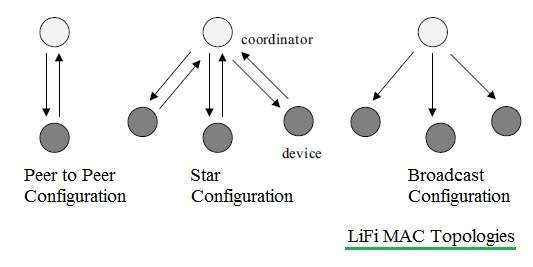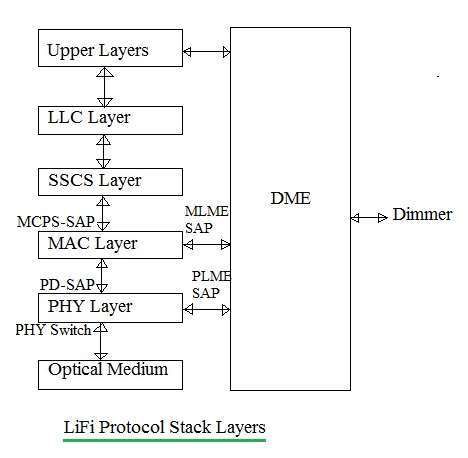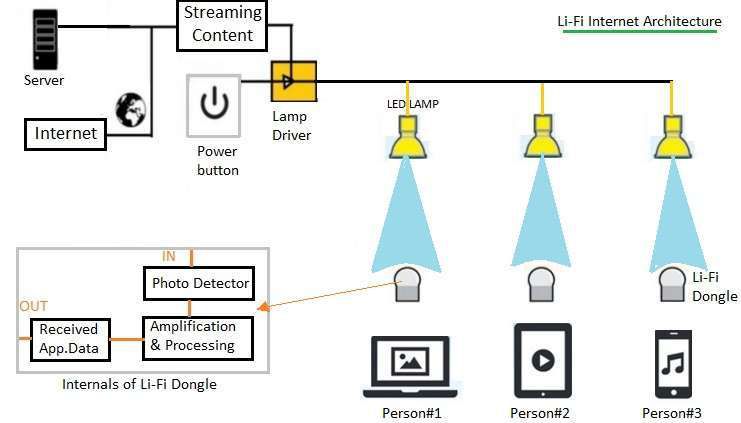Introduction to LiFi Internet
Do you hear of Li-Fi? Maybe you are familiar with Wi-Fi in today’s network world, but you may not know much about the new Li-Fi.
What’s the Li-Fi? 
LiFi is the short form of "Light Fidelity". It works on the principle of Visible Light Communication (i.e. VLC). The network is also referred as VPAN or VLC Personal Area Network. The VLC transmits data by intensity modulation. It uses LEDs and Laser diodes (or photo detectors) at transmit and receive ends respectively. It works in 380 nm to 780 nm optical band which is visible light and hence the name VLC.
The VLC standard or VPAN standard defines three classes of devices viz. infrastructure, mobile and vehicle. These devices operate in one of the three topologies mentioned below. The different device has different coverage range, data rate and other requirements.
In this article we will share the LiFi tutorial that covers LiFi system basics. This LiFi tutorial covers LiFi network architecture, LiFi protocol stack, LiFi PHY, LiFi MAC, LiFi bands, LiFi modulation types (OOK, VPPM, CSK).
LiFi Network Topologies
It works in three modes as mentioned above in the figure above. In star topology, communication is established between central controller (i.e. coordinator) and devices. In peer to peer topology, one of the devices should become coordinator at the time of establishing association.
Each device or coordinator has unique 64 bit address. Device can use 16 bit address also upon request at the time of establishing association with coordinator.

LiFi Protocol Stack

The figure above depicts protocol stack used in a typical VPAN device. As shown protocol stack consists of PHY, MAC and upper layers.
Physical layer houses light transceiver. PHY switch housed in PHY layer interfaces with optical SAP which connects it to the optical medium. The optical medium composed of one or multiple optical sources or optical detectors (e.g. laser diodes or photodiodes).
MAC layer provides channel access for all types of data and control message transmissions.
Upper layer consists of network layer and application layer. Network layer takes care of providing network configuration, network manipulation, message routing etc. Application layer takes care of providing intended functionality as needed by the VPAN or LiFi device.
DME (Device Management Entity) is also supported by LiFi or VPAN network architecture. It makes interfacing between dimmer and PHY/MAC a reality.
LiFi PHY
There are three types of physical layer configurations supported in VLC or LiFi System Viz. PHY-I, PHY-II, PHY-III. Different rates can be achieved in different configurations. They can be used indoor or outdoor.
Refer LiFI PHYSICAL LAYER➤.
LiFi MAC
MAC layer takes care of resource management i.e. allocation of channels, IDs as well as entire network management. Refer LiFi MAC LAYER➤.
LiFi Modulation Types-OOK, VPPM, CSK
There are different modulation schemes used in different physical layer modes. OOK stands for On Off Keying, VPPM stands for Variable Pulse Position Modulation and CSK stands for Color Shift Keying.
READ MORE➤.
Applications of LiFi or VLC system

There are many applications of LiFi or VLC system as lighting and data communications. Typical among them are lighting, signboards, street lights, vehicles and traffic signals or lights. The figure mentions emerging application of LiFi for internet data communication. It has also become popular due to wide adoption of IoT based technologies.
READ MORE➤.
Benefits of LiFi System
Following are the benefits of LiFi system:
• It transfers data very rapidly.
• It transfers data securely as it can be used in Line of Sight mode of optical signal. It does not pierce through the walls and hence it cannot be easily intruded by hackers.
• It uses much low power for transmission compare to other systems such as WiFi.
Note: Information provided on this page is derived from IEEE 802.15.7-2011 draft version. The standard describes PHY layer and MAC layer of Short Range Wireless Optical Communication using Visible Light. The standard is also referred as VPAN or VLC-PAN. Here 'V' or 'VLC' stands for Visible Light Communication. Pls. refer latest standard specifications published time to time by IEEE for any updates.
Info & Reference from http://www.rfwireless-world.com/Tutorials/LiFi-tutorial.html
What do the Audiences say about the new Li-Fi?
Shabaz202khan Jun 8, 2016
Lifi is nowhere near to become Wifi's alternative. There a huge difference between their working hence, application areas. Wifi is a lot more flexible to use than Lifi. It can be used parallel with wifi but there's no way it will replace wifi completely.
Here are some facts to support my upper statement. No matter how fast or secure Lifi is, there are still few drawbacks and limitations that may stop it from becoming a true alternative to existing wifi. Let me write a few-
1. Range and Line of Sight: This one is pretty common. Lifi requires a direct line of sight to work efficiently; your signal can be interrupted by almost any obstacle lying between you and your lifi source. Light can't pass through walls, hence, your signal is restricted to the room only; where the light can't reach. If you move out of sight of LED, you lose connectivity.
2. Cost: As I already told above, you need to be strictly in direct sight of LED to use it efficiently, meaning you may need at least one device for each of your sitting places in your house. And you also need an individual lifi receiver for each of your device that you want to use the internet on. Plus the fact that you may need to rewire your house too as the lifi LED will need ethernet wire to produce work. The cost is going to be way more than normal Wifi.
Juan Gonzalez
Comcast already use Wi-Fi with speeds over 2GBps, faster than the one you are talking. But, but, I belive that I read that Li-Fi is able to get over 200 GBps, so I think you need to update your information about this matter.
Read this http://www.telegraph.co.uk/technology/apple/iphone/12107410/Future-iPhones-could-feature-Li-Fi-a-technology-100-times-faster-than-Wi-Fi.html
RobStow
If 1Gbps is 100 times faster than your WiFi, that implies a slow10 Mbps WiFi.
I just transferred, via WiFi, a 3.909 GB rar file from my desktop to my laptop. That took 961 seconds ... which means I got about 32.5 Mbps *REAL* transfer rate. The modem/router from my ISP is about 2 years old and my laptop and desktop are both about 3 years old: might the file transfer have gone faster with newer/better hardware?
More reviews you can read here:
http://www.ibtimes.co.uk/lifi-internet-breakthrough-224gbps-connection-broadcast-led-bulb-1488204
More topics related to internet you can read here: http://blog.router-switch.com/category/internet-2/



/image%2F1490247%2F20190327%2Fob_8eebea_networking-for-digital-intro.png)
/image%2F1490247%2F20190322%2Fob_2f91e9_802-11ac-vs-802-11ax.png)
/image%2F1490247%2F20190228%2Fob_15918d_cat9200.png)
/image%2F1490247%2F20190214%2Fob_219b31_cisco-900-series.jpg)
